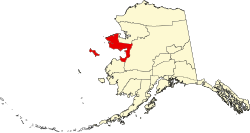References
- ↑ Patty, Stanton (April 13, 2008). "'The Last Train to Nowhere' sits outside Nome, a ghost on the tundra". Seattle Times . Retrieved February 27, 2023.
- ↑ Pacific Monthly (Public domain ed.). Pacific monthly published Company. 1902. pp. 269–. Retrieved April 6, 2013.
- ↑ Smith, Philip Sidney (1910). Geology and mineral resources of the Solomon and Casadepaga quadrangles, Seward Peninsula, Alaska (Public domain ed.). Government Printing Office. pp. 9–. Retrieved April 6, 2013.
64°33′20″N164°24′53″W / 64.55556°N 164.41472°W
